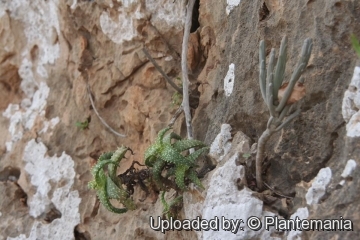
Aloe squarrosa Photo by: © Plantemania
Origin and Habitat: Aloe squarrosaSN|27090]]SN|27090]] is only known from a few scattered sites on the north facing precipices of the Ma 'alii Escarpment which overlooks the Bay of Oa'allansiya, on the western limestone plateau of Soqotra (Yemen).
Altitude range: Altitude of 300–530 metres above sea level.
Habitat and Ecology: This species is restricted to cliffs on the limestone plateau at the western end of Soqotra; also rarely found away from cliffs in the protection of shrubs such as Buxanthus hildebrandtii and Croton sp. Aloe squarrosaSN|27090]]SN|27090]] is threatened by habitat destruction and is destroyed by by large herds of goats. It is certainly still true that the numbers are low, but populations are typically found on inaccessible cliffs and it unlikely to be eaten except in times of severe drought. However, even small-scale collecting of this attractive succulent could threaten the survival of subpopulations.
Synonyms:
See all synonyms of Aloe squarrosa
back
Accepted name in llifle Database:Aloe squarrosa Baker ex Balf.f.Proc. Roy. Soc. Edinburgh 12: 97 1884Synonymy: 3
back
Common Names include:
RUSSIAN (Русский): Алое скварроза
Description: Aloe squarrosaSN|27090]]SN|27090]], a small short-stemmed aloe with stem and branches formed from the base and lovely, white spotted leaves. Originally described on the basis of herbarium material by I. B. Balfour in 1881, it was for close on 90 years considered distinct from another species, Aloe squarrosaSN|27090]] (later renamed Aloe zanzibaricaSN|636]]SN|27092]]), but it is clear that both represented one and the same species.
Similar species: Aloe squarrosaSN|27090]]SN|27090]] is frequently confused with Aloe juvennaSN|27092]]SN|636]] from Kenya. However Aloe squarrosaSN|27090]] has longer, smooth, spotted leaves that curve markedly backwards and are kept only around the head or top of each stem. Commoner Aloe juvenna has shorter, non-recurved triangular leaves and grows long stems, with the leaves retained all along the stems. Aloe squarrosaSN|27090]]SN|27090]] is relatively rare in cultivation.
Derivation of specific name: Latin adj “squarrosus”spreading horizontally; curved at the ends in reference to the leaves.
Stem: Thin, erect to pendant, 10-20 cm long, 7-8 mm thick.
Leaves: On a loose rosette, triangular-lanceolate, tapering, spreading, tip recurved, about 5-7(-8) cm long, 2-3 cm wide at the base, leaf surface is rough pale green to yellow-green , with numerous white rounded spots and transverse bands (some forms have no spots and are darker green), margins cartilaginous, armed with firm, triangular, acute teeth, 3-4 mm long, 4-5 mm apart. Leaf sheath amplexicaul. These recurved leaves are kept only around the head or top of each stem, with dead leaves falling off the lower parts of the stem.
Inflorescences: Usually simple pendant and daintily curved upward, raceme 10-15(-20) cm long.
Flowers: Pedicels (7-)8-10(-11) mm long corolla red 20-25 mm long, cylindrical, tapered base. At the level of the ovary, the flower has a diameter of 5 millimeters. Tepals free for 5-6 millimeters. The stamens and tstyle exerted 1 to 2 millimeters from the flower.
Chromosome number: 2n = 14.
Bibliography: Major references and further lectures
1) Miller, A. 2004. Aloe squarrosa. The IUCN Red List of Threatened Species 2004: e.T44898A10951673. Downloaded on 19 November 2015.
2) Hermann Jacobsen “Abromeitiella to Euphorbia” Blandford Press, 1960
3) Hermann Jacobsen “A Handbook of Succulent Plants: Descriptions, Synonyms, and Cultural Details for Succulents Other Than Cactaceae,” Volume 1 Blandford Press, 1960
4) Wikipedia contributors. "Aloe squarrosa." Wikipedia, The Free Encyclopedia. Wikipedia, The Free Encyclopedia, 20 Sep. 2015. Web. 19 Nov. 2015.
5) Susan Carter, John J. Lavranos, Leonard E. Newton, Colin C. Walker “Aloes. The definitive guide.” Kew Publishing, Royal Botanic Gardens, Kew 2011.
6) Leonard Eric Newton: Aloe squarrosa. In: Urs Eggli “Sukkulenten-Lexikon. Einkeimblättrige Pflanzen (Monocotyledonen”). Eugen Ulmer, Stuttgart 2001.
7) Urs Eggli, Leonard E. Newton “Etymological Dictionary of Succulent Plant Names” Springer, Berlin/Heidelberg 2010.
8) Susan Carter “Flora of Tropical East Africa - Aloaceae” 1994
 Aloe squarrosa growing on limestone cliffs at Socotra. Photo by: © Plantemania
Aloe squarrosa growing on limestone cliffs at Socotra. Photo by: © PlantemaniaSend a photo of this plant.The gallery now contains thousands of pictures, however it is possible to do even more. We are, of course, seeking photos of species not yet shown in the gallery but not only that, we are also looking for better pictures than those already present.
Read More... Cultivation and Propagation: Aloe squarrosaSN|27090]]SN|27090]] needs full sun in general or light shade summer. Its main growing periods are spring and Autumn. This species is dormant in winter.
Moisture requirements: Keep relatively dry, careful watering is required, as it is prone to rot if overwatered, especially in the winter months.
Hardiness: Tender, frost protection is required keep it at or around 5-10°C in winter, this plant requires winter heat, and in temperate regions is cultivated under glass.
Propagation: Via offsets or seeds.












